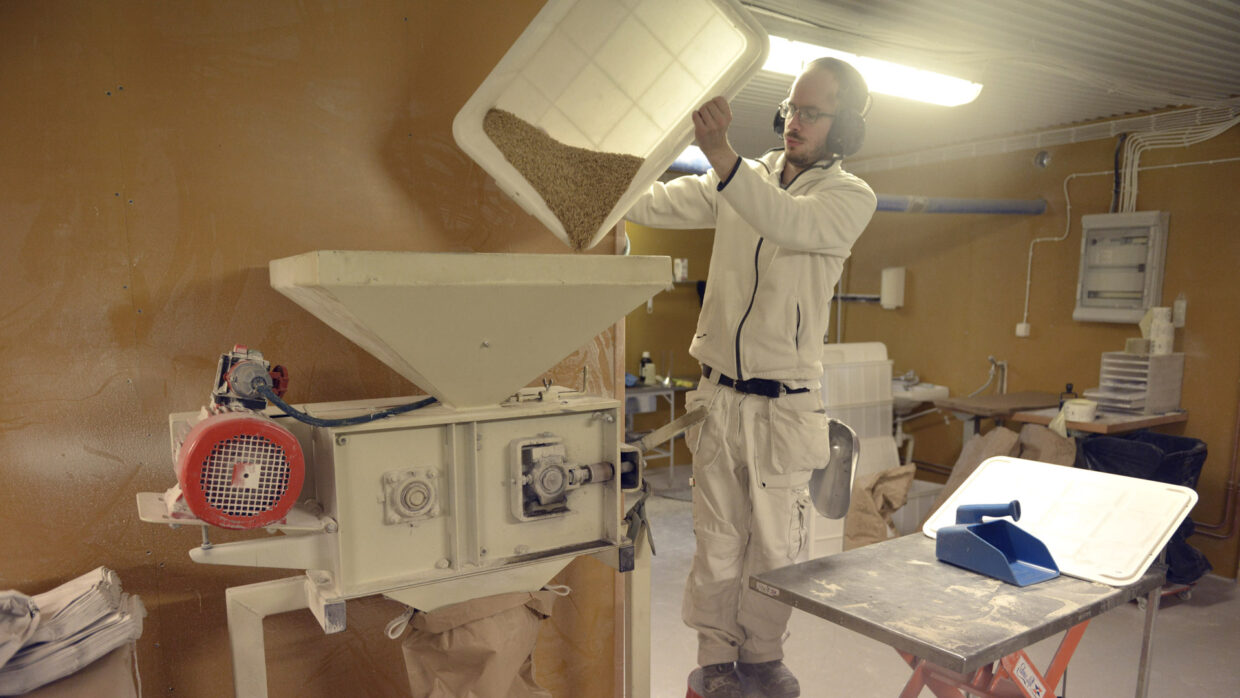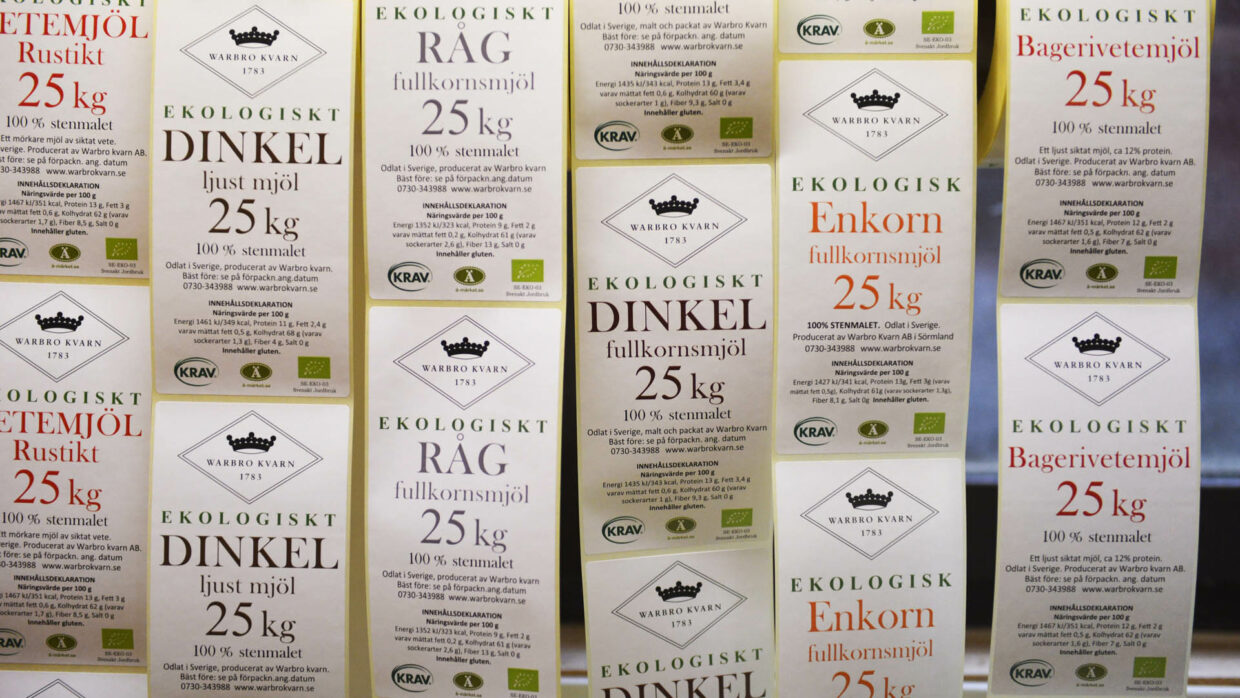Thomas Björklund´s interest in producing hydrothermally treated grains came after he started producing organic barley malt for the fast-growing industry of local handcrafted beers in 2017. Being a trained agronomist with a keen interest in advanced plant biology he soon realised that hydrothermally treating grains – a more refined and scientific way of malting – could increase the nutritious – and financial – value of his indigenous organic crops. “It releases nutrients that otherwise wouldn´t be accessible to us,” he says.

Tomas Björklund weighs grain for milling and delivery to local bakeries.
The nutrients which are mostly at stake here are zinc and iron, as well as other micronutrients. But iron is double-edged sword. In its organic form it’s an important nutrient which many, especially young women, are suffering a deficiency. But when given to humans in the non-organic form; as an additive in many of the food products we eat today, it becomes dangerous.
“The problem is that in its non-organic form, it´s like adding iron dust in your food,” says professor and medical doctor Kerstin Fredlund, the founder of the Hidden in Grains Company and an expert-in-demand by government and international health-promoting bodies. “Our bodies cannot digest or absorb it, which leads to several diseases. One is type-2 diabetes, which is soaring in the western world.” She has teamed up with Mr Björklund to develop nutritious grain products. “Grain is a fantastic food, but unfortunately it has a very bad reputation, which it doesn’t deserve,” Mr Björklund says.
Nutritional value
The key problem is the processing of modern grain varieties. Having not been exposed to the highly effective breeding process focusing on increasing yields, indigenous varieties contain more nutrients. But current commercial varieties – which contain higher gluten and protein – could also fit the bill, if they weren’t churned through a highly industrialised process, which devoids them of much of their original nutrition.
Dr Fredlund, a specialist in primary care and with a doctorate in food sciences, has a broad knowledge of and background in farming and plant biology. In her daily vocation, she sees the results of a food industry with industrial processing that causes huge harm to the public health.
We (doctors) constantly have to sweep up the problems caused by the food industry
Kerstin Fredlund
“We (doctors) constantly have to sweep up the problems caused by the food industry and it is a losing battle, with diseases we could avoid,” she said. “And contrary to public opinion, the road to a healthier lifestyle is not through eating less meat but to eat more whole-grain products.”
The hydrothermal process, which they are now trying to perfect, is essentially simple, based on a long-practiced technique of preparing grains, but now with added scientific finesse, knowledge, techniques and plant biology skills to get the process right.
“You have to get the process right to achieve the results we need,” says Dr Fredlund. “The biggest challenge is to break down the phytic acid in the grains, necessary to make the minerals and nutrition accessible for our bodies. Studies show that the phytic acid content in indigenous Einkorn wheat is five times that of modern organic varieties, and the more phytic acid the more nutrients,” she adds.
Hydrothermal treatment of grain
Hydrothermal treatment is a processing method which unlocks nutrients in grains and allows for easy absorption of micronutrients by the human body. The technique is as simple as it is old; in principle it mimics the natural process during the seed´s germination, when nutrients are released for the next generation of plants. Ideally hydrothermal treatment would make it unnecessary to enrich food products with vitamins and minerals, which, could be harmful to the body.
If the market accepts hydrothermal processing of grain and production could be scaled up for economies of scale – then tasty, long-lasting, and nutritious wholegrain-based products could be produced inexpensively and at affordable prices for low-income consumers.
There are other techniques for releasing nutrients locked-up in grains, like germination, malting and fermentation, for example sourdough fermentation.
Source: Hidden in Grains
EU to lift limiting regulation
Indigenous grains are currently not approved by the EU as an openly-traded seeds. For now, growers have to conduct their businesses and seed trade within the industry association, Allkorn, but it will become easier next year when the EU will liberalise trading rules for organically cultivated indigenous grains. Today Mr Björklund supplies seeds to farmers on a buyback arrangement, and at his Warbro mill he is stone-milling grains from producers cultivating a couple of hundred hectares.
Fredrik Zetterqvist is one farmer supplying Warbro Kvarn with indigenous barley and wheat produced on a buy-back contract. He farms around 40ha of grain on his mixed 120ha farm in Skevbokvarn, which also includes raising some 180 steers.
We’ve had better yields with these wheat varieties than with some modern organic varieties
Fredrik Zetterqvist
“For me it´s an ideal set-up, I´m gaining from getting my seeds; I know what to grow and I know I have a buyer for it,” he Zetterqvist says. The barley was last listed on the official seed-list in 1930, and the price received of course reflects the lower yields. Indigenous varieties yield between 3 and 4t/ha but are harvested with a standard combine. “We´ve had better yields with these wheat varieties than with some modern organic varieties,” Mr Zetterqvist says.

Thomas Björklund runs a mixed farm in Sköldinge with animal husbandry and the cultivation of grain seeds.
Farming and economy
The new avenues offer bright prospects of adding value on the farm. Organic flour made from indigenous varieties already demands a retail price six times that of a conventional flour.
Mr Björklund cites business confidentiality for not giving out the farm gate price he is offering, but working back from the retail price (based on the conventional retail price share) farmers could be receiving around 6 Skr/kg (£510/t). That would make farming indigenous varieties for these purposes economically viable even for smaller farmsteads. And the 100ha Björklund family holding – of which only 30ha is cultivated – is proof of that. “The farm itself is too small to offer sufficient conventional returns,” he says.
We produce about 30t of bran which we wouldn’t have any use of. Now we can feed our livestock with it.
Thomas Björklund
Cultivating indigenous grains also offers synergies for organic livestock farmers like Messrs Björklund and Zetterqvist. “We produce about 30t of bran which we wouldn’t have any use of. Now we can feed our livestock with it,” says Mr Björklund.
For Mr Zetterqvist the long-strawed indigenous crop makes him self-sufficient in forage. “That is usually a big expense for organic livestock farmers so it is a big plus for me to be able to produce it myself.”
Next step forward

Kerstin Fredlund smells the grain for deciding the correct hydrothermal treatment.
The market for food products from indigenous crops has grown slowly but steadily. Mr Björklund reckons several thousand hectares are growing indigenous crops today and that could easily double as more consumers become aware of the health benefits and the new step he is undertaking together with Dr Fredlund.
“We now want to see if we can scale this production up with Thomas´s 3t grain bins now being used for barley malt,” says Dr Fredlund.
Although the products should help with diseases caused by low fibre foods the breakthrough might be in the developing world with what she describes as the “hidden hunger”: That is, food with too few nutrients – mostly zinc and iron. This could be where their products will have market success sooner rather than later.
But as diabetes, cancer and heart diseases increase in the western world, the concept of eating your health instead of eating yourself into a disease is also gaining traction. That said, Mr Björklund prefers the slow development of the market, as it has already gained momentum, and tells politicians to stay clear.
“It´s better the market grows organically as it has,” he says. “It´s never good when politicians tell you that you can grow so much of this or that.”
The human body´s need for and processing of fibre
The human intestinal system needs a variety of nutrients to function well, and a healthy gut system is vital to keep many diseases at bay. Fibre from different food sources affect the intestinal system at specific places; for full coverage one needs to eat 30 different plant fibres per week and 80g of whole grains per day. We have 1,300 different intestinal bacteria and they require different kinds of fibres.
Source: Kerstin Fredlund



